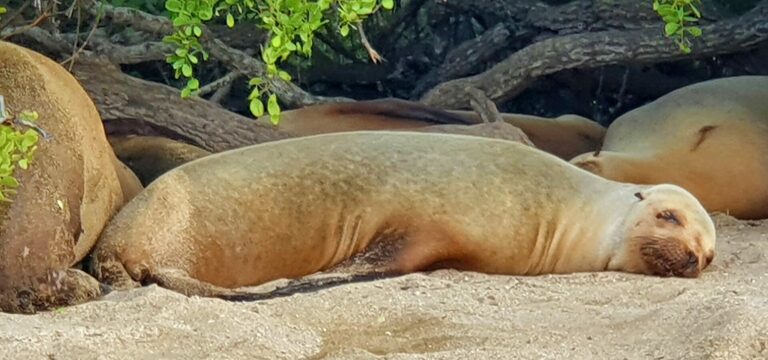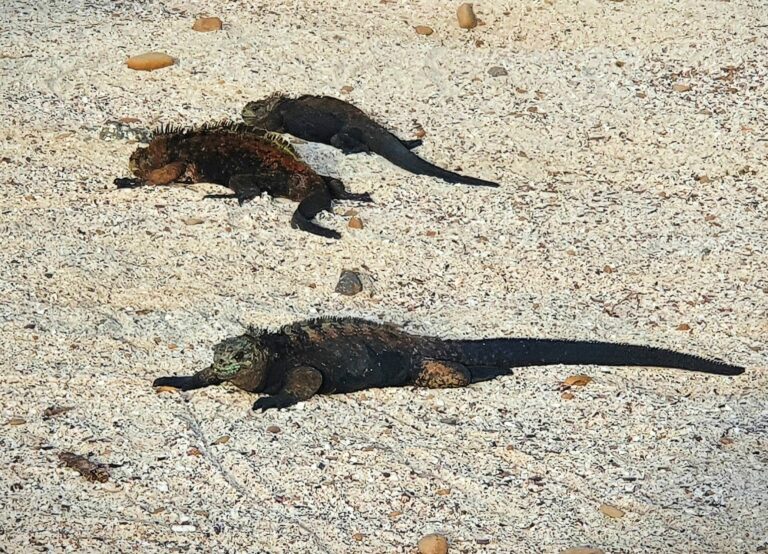On the Road is a weekday feature spotlighting reader photo submissions.
From the exotic to the familiar, whether you’re traveling or in your own backyard, we would love to see the world through your eyes.
lashonharangue
Back in February my spouse and I went to the Galapagos to tick off one of our bucket list items. We flew into the port city of Quayaquil and then, after a day to recuperate from the flights to Ecuador, flew on to the island of San Cristobal. We met other folks going on the same ship that we had booked passage on, the Natural Paradise. Herded onto a bus, we then drove to the nearby port and got onto small inflatables that motored us to the ship. We got settled into our cabin as the ship went to our first early afternoon visit, a tiny uninhabited island called Kicker Rock, just off the coast of San Cristobal.

The ship circled around the rock so we could see it from all directions.

There were a few birds nesting there (notice the white). We got to see how eroded it was with cracks going clear through in a couple of places. The ship then sailed a short distance back toward San Cristobal and anchored for our first land excursion in the late afternoon.

The inflatables landed us on the beach. We did a short hike accompanied by our naturalist guide. Almost all the land hikes were under 3 miles. These are very regulated by the government of Ecuador, with the ship having to reserve a specific time slot, and the group always accompanied by a certified guide (ours had been doing this for over 10 years).
We saw a lot of sea lions. Some were keeping cool under shade in the vegetation just up from the shore.

Most of the sea lions were out in the sun just sleeping, but this one wanted to make some noise.

This young sea lion was lying on the sand when we walked up. He seemed interested in us, got up and gave me this quizzical look. One of the best things about the Galapagos is the lack of fear the animals show towards people. It allows you to get close to take great photographs. The lack of fear is due to the fact that, while there were visits starting as early as the 16th century, people didn’t impact the islands much until whalers came about 200 years ago.

Iguanas are one of the animals the Galapagos are known for. The land iguanas are usually brown or orange. This one had been keeping cool underneath the vegetation.

The marine iguana is the only such species in the world. These were heading out to the ocean to feed on the algae. They also can be various colors. The easiest way to distinguish them from the land species is the row of spikes that go the length of their body, as well as the conical scales on their head.

As the sun got lower it was time to return to ship. Here is a photo of Kicker Rock from the beach that illustrates how it got its name. I don’t know where the ball landed.
Next stop – North Seymour Island

dr. luba
One of my favorite trips, ever. Early 90s. 7 days at sea, with 1-2 landings daily. Such amazing wildlife. This trip really awakened my love of nature travel, and reawakened my love of birding…..
Also, typo: it Guayaquil.
raven
Awsome!!!
oldster
Nice structure — you showed us a glimpse of Kicker Rock at the start, and saved the full reveal for the kicker.
Geminid
Thank you for this post. I will be forwarding it to my friends.
Have you read Hermes Melville’s The Encantadas? It’s a series of ten short “philosophical sketches” originally published by Putnam’s Magazine in 1854. The “Encantadas,” or Enchanted Islands, are the Galapagos Islands.
Melville saw the South Pacific as a young sailor but he never visited the Galapagos. He used accounts by other travelers and his poetic imagination to depict a somewhat magical archipelago. The Encantadas marked a comeback of sorts among literary critics who had written Melville off after his big flop of 1851, Moby Dick.
p.a.
Thanks! I hope to get there too. Looking forward to the rest if the series.
Cephalus Max
Great pics! I do a lot of work there — It’s a really interesting place.
The marine iguanas are my absolute favorites. So ungainly on land, so graceful in the water. They sleep in big piles at the edge of the coastal vegetation at night (cold-blooded — one of the honking big ones will park itself somewhere and then a bunch of smaller ones will start climbing on top).
The reason for the strict timing is that that the Galapagos Park restricts how many people can visit those special–normally off-limit–spots each year for conservation reasons. Only 3% of the land area is inhabited — the rest is off-limits.
Dorothy A. Winsor
What a beautiful trip!
OzarkHillbilly
Nice pics, looking forward to the next installment
eclare
Wonderful! Thank you for letting me tag along!
Kevin
Very cool. Looking forward to the rest of the adventure.
lashonharangue
Thanks everyone. Glad you all are looking forward to more posts.
arrieve
Chiming in late, but great pictures, and I also can’t wait to see the rest. The Galapagos was one of my favorite trips, and top of the list for a return visit.
apieceofpeace
From California, that expanse of water looks like a mirage this morning. Terrific photo – enjoyed the kicker and from a different spot can imagine the sun and ‘shoe’ meeting one another.
cope
Wonderful pictures of a unique part of the world. It took me a few seconds to get the whole Kicker thing but I eventually saw the light.
Thank you.
StringOnAStick
We went there in 2000; it is a magical place. We were in a 20 person land-based group (husband gets seasick) doing daily excursions by boat; the day where we snorkled with the juvenile sea lions, who love it if you do water acrobatics like they do and will play with you, is something I will never forget.
The requirement for a certified guide at all times is fantastic; they can tell you so much and are very experienced. The immigration control is very strict, as it should be in order to maintain this miracle of a place.